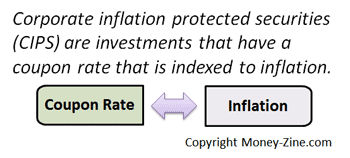Inflation has the subtle ability to erode what are otherwise reliable sources of income. That's certainly been the case with corporate bonds. As interest rates rise, the value of a bond will fall; unless they're inflation-linked bonds. With these investments, the coupon rises with inflation, as does the payment provided to the bondholder. In this article, we're going to be talking about the topic of corporate inflation-linked bonds. That discussion will include a brief explanation of how these investments work, including an example. Next, we'll review the pros and cons of these specialized bonds. Finally, we'll talk about how to find these offerings in the marketplace today.
Inflation-Linked Bonds
Also referred to as inflation-indexed bonds, corporate inflation protected securities (CIPS), and linkers, inflation-linked bonds are investments that have a coupon rate that is indexed to inflation. Government issues that provide a similar benefit include Treasury Inflation-Protected Security (TIPS) and I Bonds, which offer investors protection against inflation by varying the principal of the bond. In this article, the topic includes those investments offered by corporations. The primary benefit of these bonds is their protection against inflation. The mechanism of protection is straightforward; the annual coupon rate of the bond varies with a measure of inflation: as inflation increases, the coupon on the bond increases. During deflationary times, the coupon rate is lowered. This means when inflation rises, higher payments are made to the bondholder. When inflation slows down, payments to bondholders diminish.
Coupon Rate Example
In this example, we have a corporate inflation-linked bond with a coupon rate of 6.000%, and a par value of $1,000. When purchased, the bondholder would receive $60.00 per year in payments. Let's suppose the forces of inflation demand the bond pay holders $72.00 per year. To do so, the coupon rate of the bond needs to increase to 7.200% (7.200% x $1,000 = $72.00).

On the other hand, inflation might slow down to an extent that bondholders would only be entitled to $54.00 per year. To do so, the coupon rate would decrease to 5.400% (5.400% x $1,000 = $54.00)
Terms and Conditions
Corporate inflation-linked bonds are debt instruments that have their coupon rate linked to inflation. The rate paid on the bonds is typically aligned with an established measure of inflation such as the Consumer Price Index (CPI). Unlike TIPS that vary bond principal with inflation, these securities vary coupon rate. The bonds are usually offered with maturities of five to ten years. The coupon rate typically consists of a fixed and variable component. The variable portion of the coupon rate is oftentimes linked to a trailing 12-month Consumer Price Index. Coupon rates are updated monthly, and payments are made on the same schedule. This mechanism provides investors with a source of income that reacts quickly to the forces of inflation.
Pros and Cons
The primary benefit of corporate inflation-linked bonds is their ability to help insulate the investor from inflation. These funds also have a low correlation to other asset classes. For example, they may not move in the same direction, or to the same degree, as the stock market. Unfortunately, these funds are still exposed to the credit risk of the issuing company. Therefore these bonds carry a risk of default. They're also indexed to a measure of inflation that might not match the bondholder's actual increase in living expenses over time. Finally, when deflationary times are present, these bonds offer investors below-average returns when compared to traditional bonds.
Inflation Protection Offerings
As is the case with TIPS and inflation-protected annuities, the market for corporate inflation-protected bonds is relatively small. Investors looking to buy these securities may struggle to find these offerings in the marketplace. Mutual funds offering protection via bonds will contain TIPS, but it may be nearly impossible to find CIPS offerings. Investors interested in buying this type of bond need to work with a knowledgeable bond broker. The market for TIPS has been slow to develop in the United States; corporate offerings will take even longer to become mainstream products.



